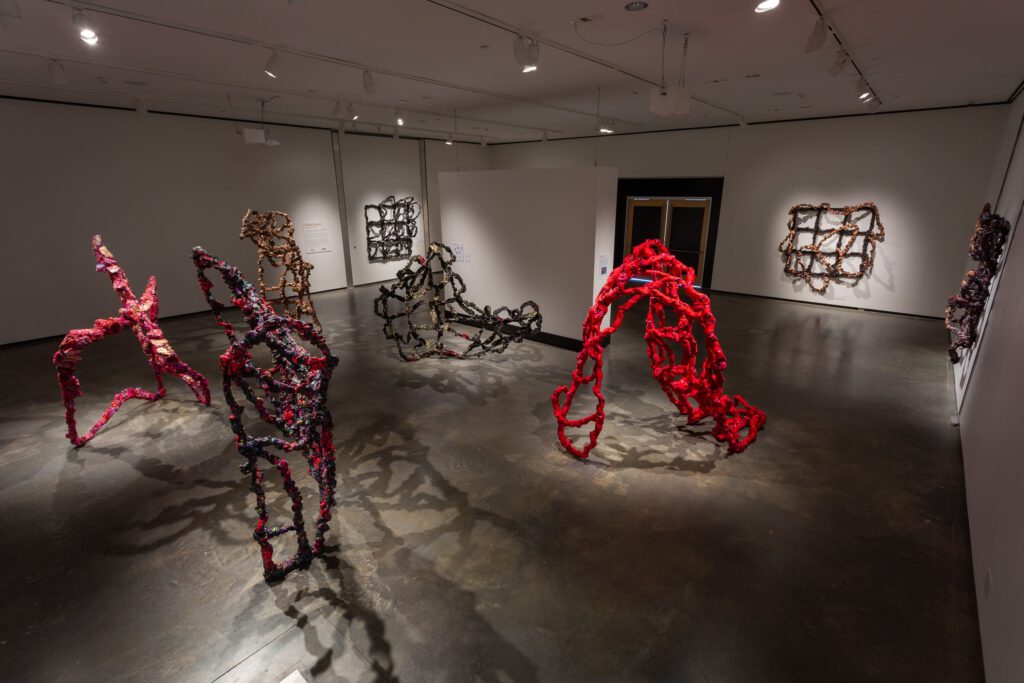Vadis Turner Delves into Stories of Mythological, Historical and Literary Female Outcasts

Widewalls | August 8, 2023
By Vittoria Benzine
Above:
Installation view of ‘She Drank Gold’ at Abroms-Engel Institute for the Visual Arts at the University of Alabama at Birmingham
Female outcasts from various canons dance to the beat of Matisse in She Drank Gold, the latest solo show by Nashville-based mixed media artist Vadis Turner, on view through August 12th at Abroms-Engel Institute for the Visual Arts at the University of Alabama at Birmingham.
One sculpture inspired by Diane de Poiter, mistress to King Henry II, cackles with abandon when you walk around or through her. Across the room, the mythical sorceress Circe crackles with fiery anger, her loose metallic crusts fluttering under the air conditioning. Half of the show’s ten textile abstractions are wall-mounted — the rest stand and dance and fight on their own feet. All but one are made from curtains affixed atop steel armatures and then coated in resin, metal leaf, driveway gravel, acrylic paint and more. Conduit (2021), the exhibition’s earliest work and the only one in the show not centered around a narrative character, is also the only artwork made of bed sheets, imprinted with the years of dreams and nightmares played out upon them.
A suite of wall-mounted “hysterical grids” opens She Drank Gold, from Pluto’s moon Charon to the trickster goddess Pandora, before Turner’s forms, which she considered windows or portals, start to jump off the wall with agency. This whole series is three years in the making, elaborating on her interest in strong-arming donated domestic materials (both decorative and practical) to tell different stories than they were intended to. Until “they bite back,” Turner added amidst the moody space, kept dark with blackout appliques over its glass doors to highlight the dramatic spotlights on her energetic forms. “These materials really have the potential to speak in a lot of ways — what I’m interested in is helping them speak in ways they’re not supposed to,” Turner explained. “They disassociate from any traditional gender roles they may or may not embody.”
Gold as Medicine
As a show, She Drank Gold takes its title from the ancient practice of drinking gold for eternal youth — which, it turns out, will kill a person, though only after stealing their sanity. Religious paintings across history exemplify humanity’s long-standing fascination with the practical and aesthetic properties of gold — the more gold a work itself or its characters features, for instance, the higher their standing, usually. No wonder we once thought drinking it could make magic too.
The human quest for youth is, unfortunately, traditionally associated with women. Hysteria, too, from the ‘wandering uterus; condition of Ancient Egypt up through 1980, when the American Psychiatric Association at last removed hysteria from their Diagnostic and Statistical Manual of Mental Disorders. She Drank Gold marks the debut of Turner’s “hysterical grids.” Though her work has historically explored “the expressive possibilities of the grid,” Turner noted, “now these figures are in this hysterical dance.” A small informational background on Matisse’s The Dance (1910) at the show illustrates how this work informed the exhibition, down to its arrangement.